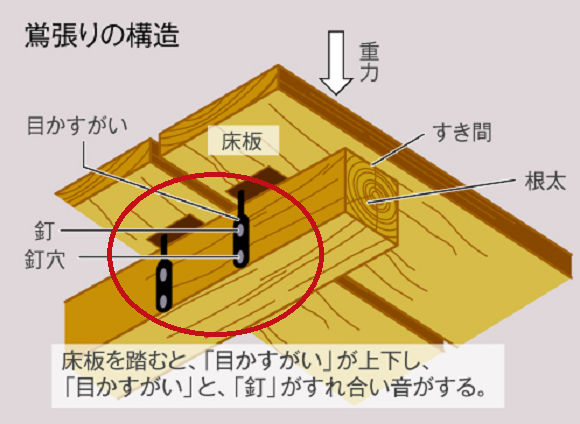For centuries, Japan has taken pride in the talents of its craftsmen, carpenters and woodworkers included. Because of that, you might be surprised to find that some Japanese castles have extremely creaky wooden floors that screech and groan with each step.
How could such slipshod construction have been considered acceptable for some of the most powerful figures in Japanese history? The answer is that the sounds weren’t just tolerated, but desired, as the noise-producing floors functioned as Japan’s earliest automated intruder alarm.
The specially constructed floors were called uguisubari. Literally translating as “bush warbler guard watch,” uguisubari are more commonly referred to in English-language texts as nightingale floors.
In installing nightingale floors, planks of wood are placed atop a framework of supporting beams, securely enough that they won’t dislodge, but still loosely enough that there’s a little bit of play when they’re stepped on. As the boards are pressed down by the feet of someone walking on them, their clamps rub against nails attached to the beams, creating a shrill chirping noise.
▼ The place where the uguisubari magic happens.
▼ Nightingale floors in action
As you can see/hear in the videos above, equipping a hallway with nightingale floors means that with every step someone takes, he announces his presence. This makes it incredibly difficult to move around stealthily, and thus nightingale floors were used as a countermeasure against spies, thieves, and assassins. By accounting for the size of the noise and the direction it was coming from, they could even be used to help pinpoint the interloper’s position.
Not just anyone could afford nightingale floors, but you can find them in historical seats of power. Kyoto’s Nijo Castle, built as a residence for the shogun during visits to Kyoto, is probably the nightingale floor location best-known to international travelers, but it’s not the only place to see this clever and classic home security system.
▼ Nijo Castle
▼ Higashi Honganji Temple, also in Kyoto
Of course, all of this raises one important question. If your security needs are high enough that you decide to put in nightingale floors, odds are you also have guards keeping an eye on your castle. So how do you tell if those chirping footsteps you’re hearing are coming from a trusted sentry or enemy ninja?
The solution is, like the floors themselves, elegantly simple. In order to tell friend from foe, the lord of the castle or captain of the guards would designate a set rhythm for allies to adhere to when walking on the nightingale floors. If they heard their “nightingales” singing at a different speed, they knew they had an uninvited guest, and that it was time to sound the alarm.
Basically, going on patrol was like a high stakes game of PaRappa the Rapper.
Source: Kaigai no Bankoku Hannoki
Insert image: Rohm


 This handsome anime-style security guard will be protecting actual homes and offices in Japan
This handsome anime-style security guard will be protecting actual homes and offices in Japan The best Japanese cosplayers from Ikebukuro Halloween Cosplay Fest 2019【Photos】
The best Japanese cosplayers from Ikebukuro Halloween Cosplay Fest 2019【Photos】 Tokyo Dome-area capsule hotel accepts female guest, offers free noodles, and has a gorgeous bath
Tokyo Dome-area capsule hotel accepts female guest, offers free noodles, and has a gorgeous bath What’s it like traversing Tokyo using only wheelchair accessible routes?
What’s it like traversing Tokyo using only wheelchair accessible routes? Animated GIFs of traditional Japanese woodworking joints are mesmerising to watch
Animated GIFs of traditional Japanese woodworking joints are mesmerising to watch Studio Ghibli unveils new goods that tip the hat to The Cat Returns
Studio Ghibli unveils new goods that tip the hat to The Cat Returns Bad tourist manners at Mt Fuji Lawson photo spot prompts Japanese town to block view with screens
Bad tourist manners at Mt Fuji Lawson photo spot prompts Japanese town to block view with screens McDonald’s Japan’s new pancake pie is a taste sensation
McDonald’s Japan’s new pancake pie is a taste sensation Starbucks at Shibuya Scramble Crossing reopens, but is it really bigger and better than before?
Starbucks at Shibuya Scramble Crossing reopens, but is it really bigger and better than before? Orange Juice Crisis ’24 – Japan’s OJ supplies drying up
Orange Juice Crisis ’24 – Japan’s OJ supplies drying up Two things to do, and two things not to do, when leaving a traditional Japanese inn
Two things to do, and two things not to do, when leaving a traditional Japanese inn History’s largest force of Samurai Colonel Sanders deploying to KFC Japan branches
History’s largest force of Samurai Colonel Sanders deploying to KFC Japan branches One of Japan’s oldest castles now lets travelers spend night on the grounds, drink in its keep
One of Japan’s oldest castles now lets travelers spend night on the grounds, drink in its keep Foreigner’s request for help in Tokyo makes us sad for the state of society
Foreigner’s request for help in Tokyo makes us sad for the state of society Studio Ghibli unveils massive T-shirt collection featuring top anime movie characters
Studio Ghibli unveils massive T-shirt collection featuring top anime movie characters Red light district sushi restaurant in Tokyo shows us just how wrong we were about it
Red light district sushi restaurant in Tokyo shows us just how wrong we were about it Japanese city loses residents’ personal data, which was on paper being transported on a windy day
Japanese city loses residents’ personal data, which was on paper being transported on a windy day McDonald’s new Happy Meals offer up cute and practical Sanrio lifestyle goods
McDonald’s new Happy Meals offer up cute and practical Sanrio lifestyle goods Japanese ramen restaurants under pressure from new yen banknotes
Japanese ramen restaurants under pressure from new yen banknotes Ghibli Park now selling “Grilled Frogs” from food cart in Valley of Witches
Ghibli Park now selling “Grilled Frogs” from food cart in Valley of Witches New definition of “Japanese whiskey” goes into effect to prevent fakes from fooling overseas buyers
New definition of “Japanese whiskey” goes into effect to prevent fakes from fooling overseas buyers Our Japanese reporter visits Costco in the U.S., finds super American and very Japanese things
Our Japanese reporter visits Costco in the U.S., finds super American and very Japanese things All-you-can-drink Starbucks and amazing views part of Tokyo’s new 170 meter-high sky lounge
All-you-can-drink Starbucks and amazing views part of Tokyo’s new 170 meter-high sky lounge More foreign tourists than ever before in history visited Japan last month
More foreign tourists than ever before in history visited Japan last month New Pokémon cakes let you eat your way through Pikachu and all the Eevee evolutions
New Pokémon cakes let you eat your way through Pikachu and all the Eevee evolutions Disney princesses get official manga makeovers for Manga Princess Cafe opening in Tokyo
Disney princesses get official manga makeovers for Manga Princess Cafe opening in Tokyo French Fries Bread in Tokyo’s Shibuya becomes a hit on social media
French Fries Bread in Tokyo’s Shibuya becomes a hit on social media Sales of Japan’s most convenient train ticket/shopping payment cards suspended indefinitely
Sales of Japan’s most convenient train ticket/shopping payment cards suspended indefinitely Sold-out Studio Ghibli desktop humidifiers are back so Totoro can help you through the dry season
Sold-out Studio Ghibli desktop humidifiers are back so Totoro can help you through the dry season Japanese government to make first change to romanization spelling rules since the 1950s
Japanese government to make first change to romanization spelling rules since the 1950s Ghibli founders Toshio Suzuki and Hayao Miyazaki contribute to Japanese whisky Totoro label design
Ghibli founders Toshio Suzuki and Hayao Miyazaki contribute to Japanese whisky Totoro label design Doraemon found buried at sea as scene from 1993 anime becomes real life【Photos】
Doraemon found buried at sea as scene from 1993 anime becomes real life【Photos】 Tokyo’s most famous Starbucks is closed
Tokyo’s most famous Starbucks is closed One Piece characters’ nationalities revealed, but fans have mixed opinions
One Piece characters’ nationalities revealed, but fans have mixed opinions We asked a Uniqlo employee what four things we should buy and their suggestions didn’t disappoint
We asked a Uniqlo employee what four things we should buy and their suggestions didn’t disappoint Amazing photos of off-the-beaten-path Japanese castles to add to your travel wish list【Photos】
Amazing photos of off-the-beaten-path Japanese castles to add to your travel wish list【Photos】 Setting up zero-cost electricity at our cheap Japanese country house so it looks less haunted
Setting up zero-cost electricity at our cheap Japanese country house so it looks less haunted East meets West in the Pacific-centered version of the world map
East meets West in the Pacific-centered version of the world map Not ready to go full tatami? This clever item adds a dash of Japanese reed flooring to your home
Not ready to go full tatami? This clever item adds a dash of Japanese reed flooring to your home Starbucks teams up with Japanese clothing brand to create stylish new contactless payment system
Starbucks teams up with Japanese clothing brand to create stylish new contactless payment system Osaka authorities finally arrest “Spider Man”
Osaka authorities finally arrest “Spider Man” Poor little dog is driven into corner by owner’s terrifying new house guest
Poor little dog is driven into corner by owner’s terrifying new house guest Book your plane tickets now: Shanghai’s official Hello Kitty restaurant looks amazing!
Book your plane tickets now: Shanghai’s official Hello Kitty restaurant looks amazing! Tokyo aquarium’s reopening showcases a revamped, ethereally beautiful jellyfish chamber
Tokyo aquarium’s reopening showcases a revamped, ethereally beautiful jellyfish chamber Tokyo’s most famous Starbucks building now has a reopening date
Tokyo’s most famous Starbucks building now has a reopening date Japanese carpenters demonstrate traditional wooden joints and it’s oddly satisfying 【Video】
Japanese carpenters demonstrate traditional wooden joints and it’s oddly satisfying 【Video】 The cheapest place to stay in Kyoto cost us just 1,800 yen for the night, and it was awesome
The cheapest place to stay in Kyoto cost us just 1,800 yen for the night, and it was awesome Brilliant Art Aquarium takes over Nijo Castle in Kyoto for a spellbinding nocturnal event
Brilliant Art Aquarium takes over Nijo Castle in Kyoto for a spellbinding nocturnal event Can people see your panties if you wear a skirt on Japan’s clear Ferris wheel? 【Experiment】
Can people see your panties if you wear a skirt on Japan’s clear Ferris wheel? 【Experiment】 The biggest “natural” hot spring spa in Tokyo is being built now, but what is its “secret?”
The biggest “natural” hot spring spa in Tokyo is being built now, but what is its “secret?” Beyond face masks – Japanese company selling anti-infection paper helmets【Photos】
Beyond face masks – Japanese company selling anti-infection paper helmets【Photos】
Leave a Reply